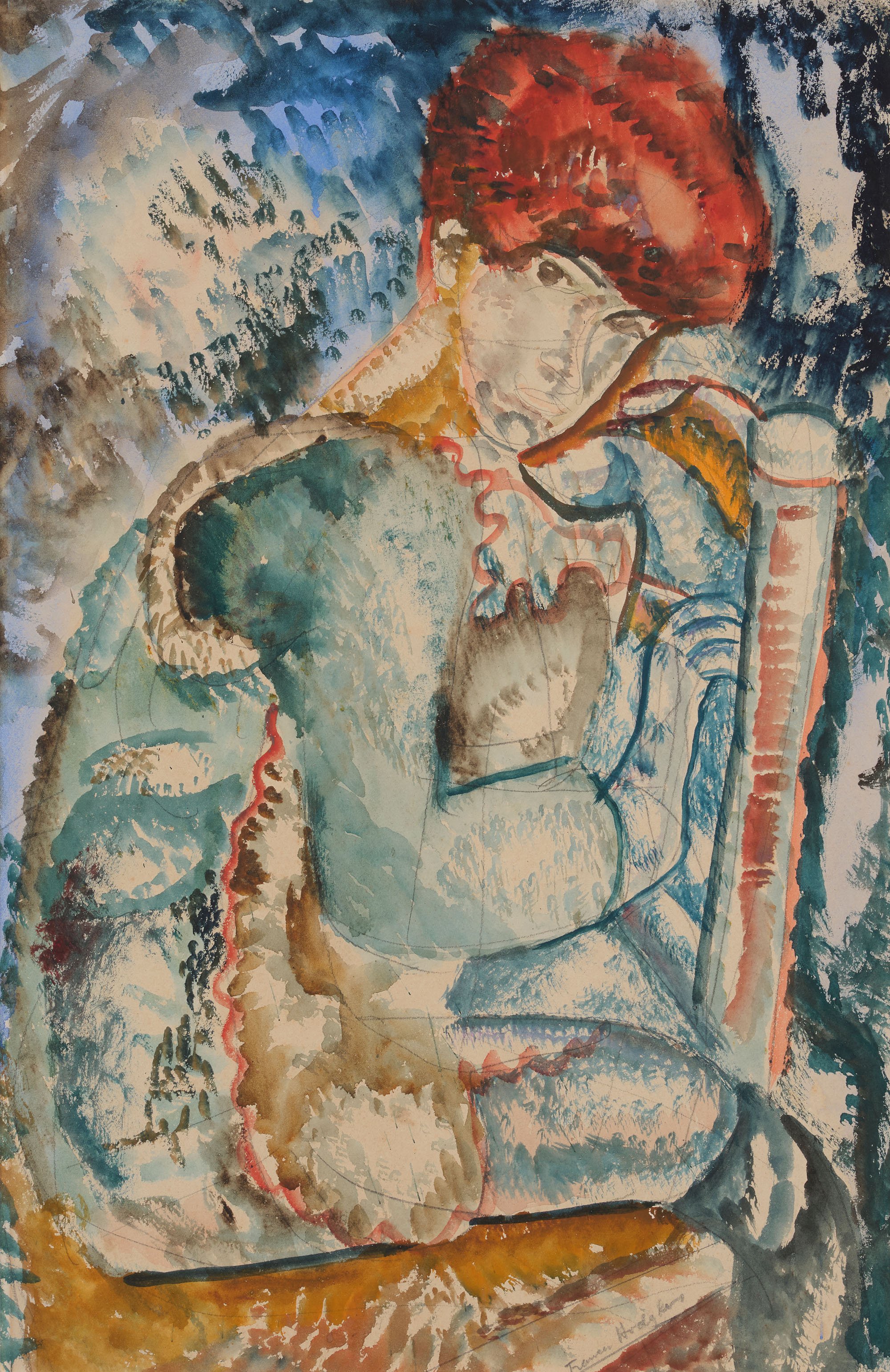Frances Hodgkins
Girl Seated on a Chair c. 1927
Gouache, 53 x 34 cm
Signed Frances Hodgkins lower right
Sold
From Frances Hodgkins to Dorothy Selby, 21st January 1928, Hotel Moderne, Martigues, Bouches du Rhone, France
“Martigues is half Spanish – I have a small room in the Spanish quarter where I have models …there is no chasing and begging on bended knee as at Tréboul – they are only too pleased to sit and gaze at you with immense eyes for as long as you like.”
At the beginning of 1927, Frances Hodgkins set up her new studio at Grosvenor Street in Manchester in preparation for teaching. With several friends, she hired a model, who had to pose semi-clad, as if basking at the seaside instead of the freezing cold of a Mancunian winter. This marked a new approach to the human figure, not as a feature in a landscape or in a portrait, but as a form to be studied for mass, line, and structure.
In June, with the promise of a week’s teaching with Dorothy Selby, who paid generously, she travelled to Tréboul, Brittany, staying in a chalet with her friends Cedric Morris and Arthur Lett-Haines. The presence of fellow artists with whom she could discuss recent developments in art, new directions each was taking, and critiquing each other’s work were invaluable. In Manchester she had painted a series of local mill girls, appearing timeless in their shawls like modern Madonnas, their forms delineated in thick, fluid brushstrokes that appear to caress the surface on which they are painted. None of these prepares the viewer for the radical experimentation that emerged in Hodgkins’ work once back in Tréboul. Painting with gouache with a thinly loaded brush, she developed new stippling effects, pressing the end of the brush hard onto the surface so that one can differentiate the tiny lines caused by each bristle. The rich blues and greens so loved by the Impressionists, the first group to influence her development in the early days, are almost obliterated, overlain by dark ochres, navy and black, and she introduces rapid parallel marks delineating parts of the body, as if appliquéing arms and legs onto the surface. Seated Woman and Portrait of a Woman (see FH0806, Auckland Art Gallery Toi o Tāmaki and FH0794, University of Otago) are but two examples of this technique. Boldly drawn lines are visible beneath the paint, seemingly unrelated to the painted form.
Gradually, as if her creative spirit has been irresistibly infused with Mediterranean warmth, colour starts to dominate, overlain initially by darker strokes, which are gradually moved to the margins of her compositions. In Girl Seated on a Chair, the model in question sits backwards on a traditional rush-woven seat – the kind loved by Braque, Picasso, and Van Gogh – her hands gripping the lower rung. She wears a short, ruffled dress over a plain blue blouse, an exuberant ochre line wriggling round the neck, down the side seam and around the hem. The pattern on her dress in indecipherable, as if a shoal of fish is swimming over the surface – a deliberate choice by an artist who had produced highly controlled designs for the Calico Printing Company in Manchester the year before.
The model’s unruly red hair is kept under control in a fashionable bob, and long socks reach over her knees. Rapid diagonal brushstrokes fill in the upper left corner, unrelated to figuration, yet heightening the mood of the work. Most remarkable is the girl’s expression. She stares suspiciously at the artist from under her dense fringe, her mouth a tight line, suggesting that though young, she already knows her own mind. It is a revolutionary work within Hodgkins’ oeuvre. Eric Newton later described Hodgkins experiments with gouache as “just rich enough to give her a full chromatic range and just flexible enough not to interfere with her fine, wild handwriting.”
But what led to this rich experimentation? The year before Hodgkins had lost her mother in April, her death finally assuaging the guilt of a daughter who had chosen career over duty. Two months later, Norman Garstin also died. When Hodgkins first moved to Europe in 1901, he recognised a fellow artist rather than an initiate, encouraging Hodgkins on her determined path. Possibly these two events, once she had come to terms with their loss, set Hodgkins free psychologically. This period in Tréboul culminated in watercolours of Breton fisher boys in which black is almost eradicated, and Hodgkins is immersed again in luminous blues and greens (see FH0791 Three French Sailors, Museum of New Zealand Te Papa Tongarewa and FH0792 Boys Heads, Tréboul 1927, Auckland Art Gallery Toi o Tāmaki).
_
Written by Mary Kisler
Reference
Frances Hodgkins Database FH0793
(completefranceshodgkins.com)
Provenance
Frances Hodgkins’ studio, Corfe Castle
Marjorie Heather 1905-1989 (purchased from Frances Hodgkins’ studio)
Thence by descent to Private Collection, Norfolk, UK

